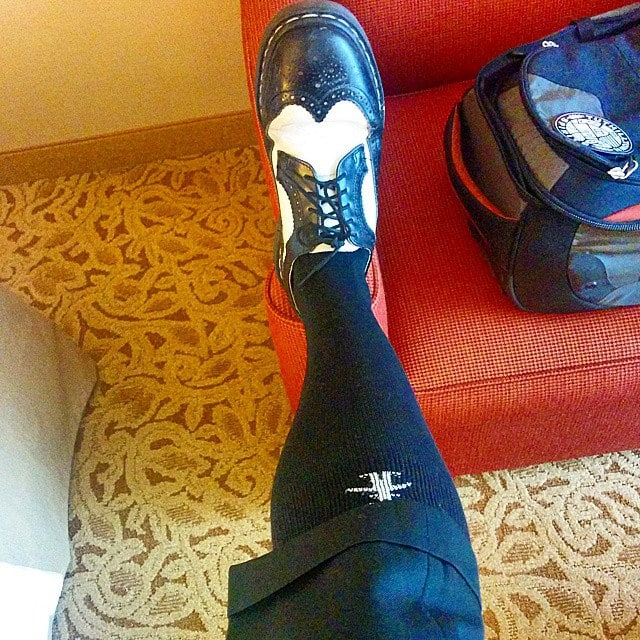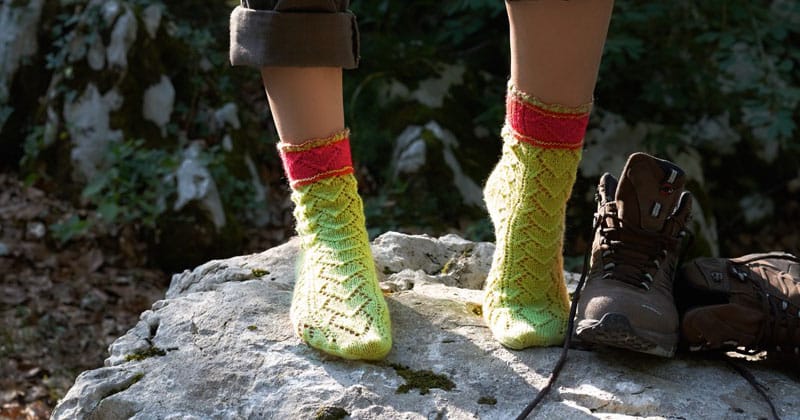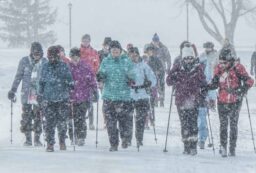When it comes to preventing blisters while hiking, shoes get the most attention. However, if you don’t have the right socks, you’ll still get blisters. Many experienced hikers wear two pairs of socks to prevent blisters.
What Causes Blisters?
If you want to prevent blisters, you’ve got to know what causes them in the first place. The type of blisters you get hiking (or doing other sports) are friction blisters.
“An object is repeatedly moved across the skin with enough force to cause the layers of skin to release heat. The heat causes redness and a separation (or cleft) between the outermost layer of the skin and the rest of the skin layers. The cleft fills with fluid causing a raised area on the skin.”
Wet, sweaty feet just make the problem worse. The moisture weakens the skin, making it more prone to injury.
The Two-Pair Sock System for Hiking
Experienced hikers will swear by this system:
- A thin inner sock. Aka sock liner, preferably made from silk, nylon, polyester, or wool.
- A thicker outer sock. This sock should be wool. Smartwool and Merino wool are the best options.
How Does this Prevent Blisters?
No system can completely prevent blisters. However, wearing two socks can help in three ways:
- Reduces friciton: The inner sock reduces friction with your foot. There is still friction occurring – it is just between the two pairs of socks and not your skin and the sock.
- Less moisture: The inner sock also helps wick away moisture from the foot. Less moisture means that your skin is less prone to damage. The second outer-layer sock also absorbs some moisture.
- Cushioning: The second sock provides some cushioning. Some really good hiking socks have padding in areas prone to blisters.
This duo of sock liner + wool sock is truly amazing for preventing blisters. It is better than just wearing one pair of breathable socks (such as Gore-Tex hiking socks). Even high-tech socks can’t wick away as much moisture as wearing two socks.

The two sock system even works with dress shoes and other uncomfortable shoes too.
Why Some People Hate the Two Sock System
The caveat with wearing two socks is that it can make your feet hotter. Heat is one of the elements which makes your feet vulnerable to blisters.
Another annoyance is that liner socks can make your boots fit too tightly. A tight fit means that you will be even more prone to blisters. If you want to use this system, you’ll probably need new hiking boots which are sized up.
How to Choose Sock Liners
A lot of major hiking companies make their own brand of sock liners. Some of the most popular brands are Wigwam, Fox River, SmartWool, Bridgedale, and Injinji (which have toes).
Most Important Is the Fit
Is the fit! If the sock liners are too big, your foot will slide around in them, creating friction and blisters. Wrinkles in the socks will also cause blisters.
Be sure you pay attention to the sizing of the liner socks. Most are sized as S, M, or L – not by shoe size. If your shoe size falls between S/M or M/L, go with the smaller size. It’s better to have them fit a bit tight than have them wrinkly.
Sock Liner Material:
There are three main options for sock liner material:
- Silk: I personally like silk sock liners best. They are comfortable, easy to slide on your feet, and do a great job of reducing friction. The downside is that they aren’t always very durable. Some brands aren’t very breathable either, so not suited for warm weather. Silk sock liners for hiking are almost always with a synthetic blend.
- Synthetic: These are very durable and can do a great job of reducing friction. They aren’t always very breathable though, especially the cheap synthetic sock liners. Some brands have their own space-age synthetics with special features for wicking away moisture.
- Wool: Thin wool sock liners are good for warm weather hiking. They are breathable and stay dry. Wool sock liners tend to be pricier though, and might be too thick to wear comfortably in your boots.
Regardless of the material, good sock liners will have a tight weave. You won’t be able to pull fibers off of them easily.
Length:
It should be obvious, but remember to consider the length of the sock liners. They should be appropriate for the type of shoes or boots you are wearing. Plus, they need to match the length of the outer sock.
Remember: You can wear sock liners that are longer than your outer sock, but can’t wear sock liners shorter than the outer sock. When in doubt, go with longer sock liners.
Best Hiking Sock Liners for Preventing Blisters
- Wigwam Coolmax liner socks
- Fox River Wick Dry Alturas Ultra lightweight Liner Socks
- SmartWool Zero liner socks
- Injinji Liner Crew Toesocks
- Terramar Thermasilk Sock Liners
Be Prepared to Try Out Many Liner Socks
Keep in mind that every hiker seems to have his or her own favorite sock liner. Some people swear by one brand whereas others hate it. You might have to try out a few different types of sock liners before you find your favorite. Luckily, sock liners aren’t too expensive.
Resources:
https://melmagazine.com/is-there-any-point-to-wearing-two-pairs-of-socks-7df2168444dd
https://www.quora.com/What-are-the-advantages-and-disadvantages-of-wearing-two-pairs-of-socks-when-hiking
https://backpackinglight.com/forums/topic/90845/
https://patient.info/health/foot-blisters
Image credits:
“I’m still waiting for my dress sock spon” (CC BY-NC-ND 2.0) by Josh Mishell,
“Gelato Socks” (CC BY-NC-ND 2.0) by sashawerner













Post your comments